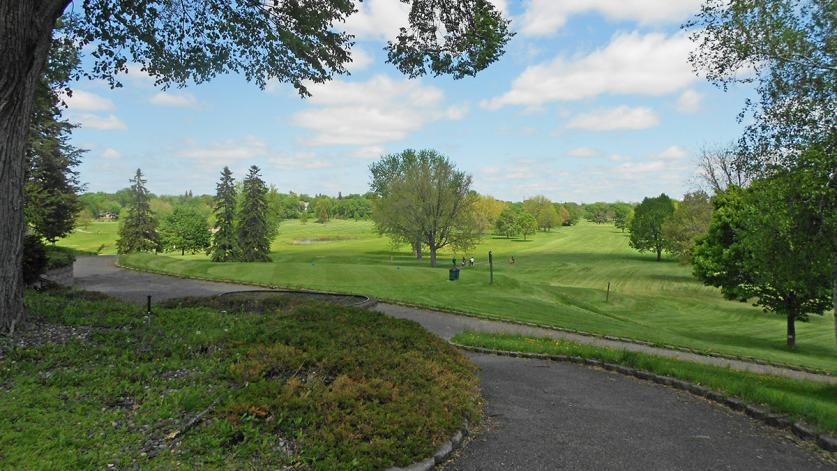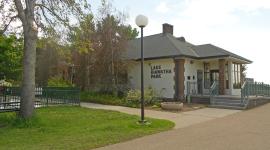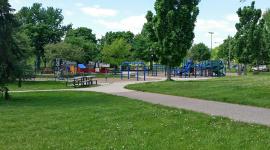Renewed Threat to Hiawatha Golf Club
A controversial plan to reduce Minneapolis’ historic Hiawatha Golf Club, which has particular significance to African American golfers, from eighteen to nine holes have failed multiple times over the past year. This threat resulted in the site being enrolled in The Cultural Landscape Foundation’s (TCLF) Landslide program on March 1, 2022. Nevertheless, several members of the Minneapolis Park and Recreation Board (MPRB) are again trying to muscle through the very same proposal. At an occasionally tense MPRB meeting on July 20, during which one commissioner described the redesign as a “manifestation of White supremacy,” a motion was passed by the Board’s planning committee that could lead to a consequential up or down vote on August 17.

The genesis of this year’s long debate is a major flood in 2014 that prompted the MPRB and others to examine measures to address the flooding that affected the course. A Master Plan was developed by a consortium of consultants led by Minneapolis-based Barr Engineering, which proposed to convert Hiawatha to nine holes, add bike and cross-country ski trails, a dog patio, and other amenities. The report states that a rehabilitation of the site that addresses the flooding and retains eighteen holes would be “impracticable, if not impossible.”
Supporters of the redesign claim the nine-hole scheme is a data-driven “compromise” this is ecologically and environmentally sound, though the equity of the “compromise” is a great source of friction. Site advocates, including TCLF and the Bronze Foundation, which operates an annual tournament at Hiawatha first created in 1939 for Black golfers, say the MPRB has failed to do the necessary research about the site’s historical and cultural significance. Indeed, in the Landslide designation TCLF stated: “the MPRB should retain a consultant who meets the Secretary of the Interior’s (SOI) Standards for Historian/Architectural Historian to undertake a more in-depth assessment of the landscape’s integrity and significance. Among other outcomes, this would result in a more informed period of significance for this individual resource and a better understanding of the adverse effects brought on by the proposals in the 2021 Master Plan.”
As reported on May 13, 2022, the Bronze Foundation, with support from a private donor, has stepped forward to commission the research needed to determine Hiawatha’s National Register eligibility, in the absence of any action to do so by the MPRB. The resulting nomination, being prepared by the Minneapolis-based firm Hess, Roise and Company, is expected to be filed with the Minnesota State Historic Preservation Office on or about August 10, 2022, with the anticipation of having the nomination on the agenda for the State Review Board in November, a key step in the nomination process.
This is important because, as noted in the city’s Master Plan, the proposed redesign would be subject to review pursuant to Section 106 of the National Historic Preservation Act. That arcane-sounding Section 106 review could be this project’s Achilles’ heel. Why? If the MPRB had done the necessary research critical to getting Hiawatha listed in the National Register, they would never have produced the present nine-hole plan. They would know the chances for surviving a Section 106 review with the nine-hole plan are far less likely than pursuing a more informed solution that addresses the flooding without diminishing the site’s historic integrity and significance.

Plainly speaking, the purpose of the Section 106 review is to determine if this radical and aggressive redesign would have “adverse effects” (federal parlance for negative impacts) on the historic resource. The MPRB would then have to develop ways to avoid, minimize or mitigate those adverse effects. There’s no doubt that the complete overhaul of the site, including the proposed nine-hole course, has significant adverse effects on this historic eighteen-hole course and that there are alternatives that could address the flooding issue and avoid the adverse effects.
With seven new commissioners on the nine-member MPRB (as of January 2022), there’s a sense that the nine-hole proposal could potentially get passed. But that would only be a short-term public relations victory for the MPRB, albeit one that could create more unnecessary divisiveness. Ultimately insistence on this specific redesign would become a long-term headache for taxpayers. MPRB Commissioner Becka Thompson said as much in a Minneapolis Star Tribune opinion piece on July 20, the same day of the most recent MPRB meeting.

So, why would the MPRB push through a plan they know would hit the Section 106 buzzsaw, which would cause completely foreseeable, totally unnecessary, and seriously costly delays?
Here’s some context: A decade ago, the city proposed demolishing Peavey Plaza, a nationally significant work of landscape architecture by M. Paul Friedberg. At the time the city said there was no alternative but to completely redesign the site. TCLF along with local partners including the Preservation Alliance of Minnesota (now Rethos) not only objected, but we also filed a lawsuit. Peavey Plaza was listed in the National Register in 2013 and ultimately the city pivoted and opted to rehabilitate the site. The result maintained the integrity of Friedberg’s exceptional design and addressed contemporary concerns such as greater accessibility. At the April 6, 2022, MPRB meeting, the board’s lawyer portentously cited this history and urged the board not to dismiss the significance of a Section 106 review.

The rehabilitated Peavey Plaza has been hailed a great success locally and nationally. Minneapolis Mayor Jacob Frey said of the result: “The vision that it took—from mayors to council members, to private-sector leaders, to donors—to step up and fulfill this potential is something really beautiful…it probably took some guts, and it took a whole lot of work in getting there.”
The MPRB could notch a similar victory with a rehabilitated eighteen-hole course at Hiawatha that respects the historic design integrity and addresses the environmental and ecological concerns.
So, why wouldn’t they?











